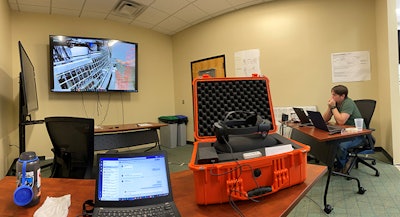
Zoetis used augmented reality to provide virtual service and support at a customer hatchery north of Buenos Aires in Entres Rios, Argentina after travel restrictions due to COVID-19 prevented an in-person installation.
Utilizing augmented reality offers numerous benefits. There is obviously the savings associated with travel, but also being able to maintain a presence and support the customer in a location when you cannot actually be there,” explained Justin McGee, Global Training & CSS Lead, BioDevices & Automation, Zoetis.
COVID-19 challenges
In 2020, an Argentina-based hatchery leased the Inovoject NXT system, an Embrex automated vaccination biodevice, from Zoetis.
Normally, a field service specialist would travel to the customer site to complete the installation, however travel restrictions and hatchery biosecurity protocols implemented because of the COVID-19 global pandemic made that impossible.
Developing a solution
The company chose to use the Microsoft HoloLens to provide service to the customer virtually. One of the biggest benefits of the augmented reality technology was the ability “to have hands-free technology which enabled our subject matter experts (SMEs) to see what the customer is seeing and walking them through solving problems they otherwise would not have been able to solve” added McGee. This feature meant that the training team was able to “see around corners” during the installation.
In preparation, the training team went through rigorous preparation, discussing what the customer needed to have and know to perform the installation correctly, beta testing the HoloLens and creating extensive checklists that documented the entire process.
“It’s important to know the amount of energy and resources that go into making it successful. It’s not just picking up a HoloLens and putting it on and off you go. One of the things that I believe made our use case so successful is the amount of planning and training and pre-work that we put into it,” McGee said.
A successful installation
The technology was successfully used to execute the virtual installation, allowing the U.S. based team to remotely direct and set up the vaccination system.
“Being able to solve a problem for the customer was a major goal for us,” added Juan Sangineto, Technical Service Representative, Global BioDevices & Automation, Zoetis. “We enjoyed feeling like we were immersed in the same world the customer saw. Even though we were far away from each other, we felt we were working very closely.”
The team plans to customize the augmented reality technology approach used in Argentina for upcoming installations in Asia and the Middle East, and other regions as needed based on COVID-19 protocols, in addition to future trainings and use cases throughout the world.
View our continuing coverage of the novel coronavirus (COVID-19) pandemic.
Like what you just read? Sign up now for free to receive the Poultry Future Newsletter.


















